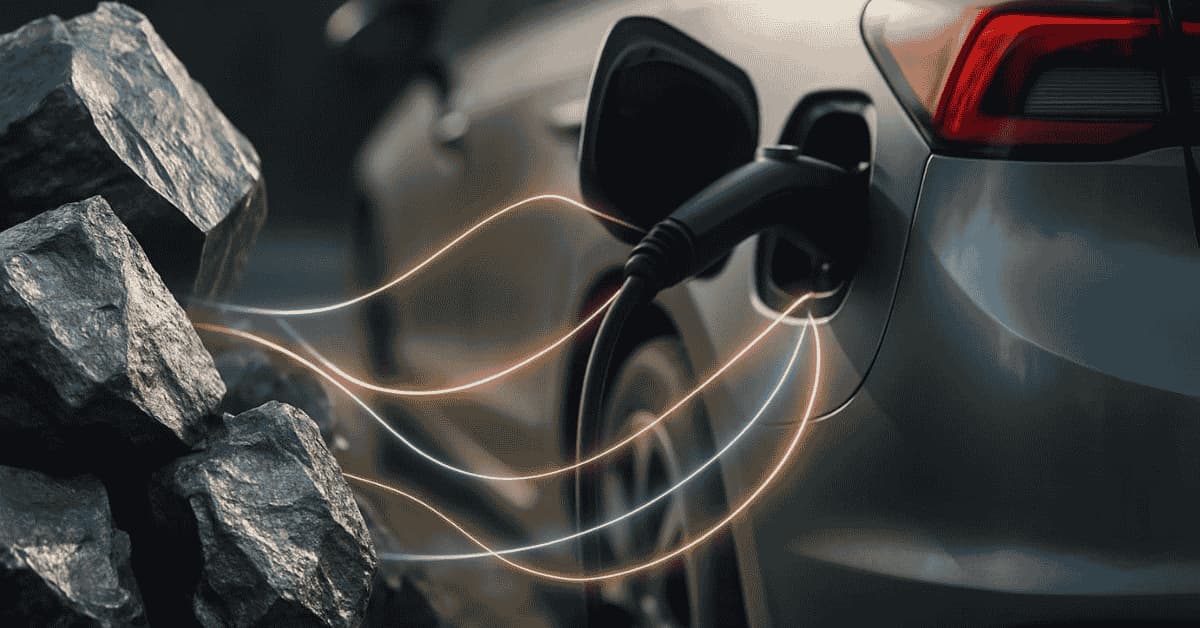What makes your electric car move so smoothly? You often hear about lithium, cobalt, and nickel when people talk about electric car batteries. But another very important material works behind the scenes: graphite. You might know graphite from pencils.
In electric vehicles (EVs), however, it’s a true powerhouse. Let’s explore why graphite is so important for the lithium-ion batteries that power our greener cars.
Think of graphite as the quiet, reliable friend in the battery group. It doesn’t always get attention. But without it, the whole system wouldn’t work as well. We are all looking forward to a future with more electric cars. Understanding materials like graphite helps us see how this amazing technology works. It also shows why getting these materials responsibly is important for everyone.
What Exactly Is Graphite?
Graphite is a special form of carbon. Carbon is the same element found in diamonds, but graphite’s structure is very different. We dig it up from the Earth. You can find it in countries like China, Brazil, and India.
There are two main types of natural graphite:
- Flake Graphite: This comes from certain rocks. It has a lot of carbon, making it very pure.
- Amorphous Graphite: You find this type in coal. It is not as pure as flake graphite.
We can also make graphite. We call this “synthetic graphite.” We produce it by heating materials like petroleum coke. Petroleum coke is a leftover product from oil refining. Synthetic graphite works similarly to natural graphite. We can sometimes change it for specific uses.
Why Is Graphite Good For Batteries?
Graphite’s structure makes it special for batteries. Think of a lot of layers, similar to stacked paper sheets. This layered structure is perfect for holding tiny charged particles called lithium ions. Lithium ions carry energy in a battery.

Graphite is a form of carbon, so it conducts electricity well. It also handles heat well. These qualities are very important inside a battery that works hard.
Natural vs. Man-Made Graphite: What’s The Difference?
Graphite comes in two forms: natural and man-made. Why do we use both? They each have unique features. Battery makers often mix them for the best electric vehicle (EV) battery performance.
1. Natural Graphite
We dig natural graphite from the earth. It costs less to get at first. But it needs a lot of work to become pure enough. We must make it 99.95% pure. We also shape it into tiny balls for powerful batteries. This process can use a lot of energy. It can also involve strong chemicals.
2. Man-Made Graphite
We make man-made graphite, often from petroleum coke. It starts very pure. We can design it to have steady features. Battery makers like this for reliable performance. It often charges faster. It may also swell less during use than some natural graphite. However, making it needs very high heat, up to 3000°C. This uses a lot of energy. It can also be more expensive.
3. A Common Mix
EV batteries often use a blend. For example, they might use special natural graphite called Coated Spherical Graphite (CSG). We coat the tiny graphite balls with a thin layer, like asphalt. This helps them resist swelling when charging and discharging. It also makes them last longer. We might then mix this CSG with man-made graphite. This creates the perfect balance of cost, performance, and long life for that battery.
Comparing Graphite Types: Natural vs. Synthetic
The two forms of graphite used in EV batteries differ primarily in the following ways:
| Feature | Natural Graphite | Synthetic Graphite |
|---|---|---|
| Source | Mined from the earth | Man-made (often from petroleum coke) |
| Initial Purity | Lower (needs significant refining) | Higher (more consistent) |
| Processing | Requires purification & shaping | Requires very high temperatures |
| Cost | Generally lower raw material cost | Higher production cost |
| Performance | Good, but can expand more | Very consistent, less expansion |
| Environmental | Mining impact, processing chemicals | High energy use during production |
| Common Use | Often processed into CSG & blended | Blended with natural/CSG |
Challenges And The Road Ahead
Graphite is a great material, but we need to consider a few things.
Supply: Most of the world’s natural graphite, especially what we use for batteries, comes from China. Also, China processes much of this graphite. Relying on one main source can cause problems like supply shortages or price changes. We saw this recently when China discussed limiting exports. Countries worldwide are now trying to find and develop new graphite sources and processing plants closer to where batteries are made, like in North America and Europe.
Environment: Mining natural graphite can harm the local environment. Also, processing both natural and man-made graphite uses a lot of energy and chemicals. The industry is working hard to find cleaner ways to mine and process graphite.
Silicon – A Possible Rival? You may hear about silicon being used in batteries. Silicon may contain significantly more lithium than graphite, perhaps resulting in a longer battery life. However, silicon has a major issue: it expands a lot (up to 300-400%) when it absorbs lithium. This expansion can damage the battery over time. Currently, most batteries that use silicon only add a small amount (about 1-5%) mixed with graphite. This gives a small performance boost without too much swelling. While scientists continue to research silicon, we expect graphite to remain the main battery material for at least the next ten years because it is stable, dependable, and well-understood.
Why Is Graphite Important to You?
Let’s talk about how graphite affects you as a driver or someone thinking about buying an electric car.
- Charging Speed: The type and quality of graphite impact how fast your car charges. Better graphite means your car charges quicker. This allows you to get back on the road sooner.
- Driving Range: Graphite stores lithium ions. This directly affects how much energy your battery holds. A good graphite anode helps electric vehicles (EVs) go long distances.
- Battery Lifespan: Graphite keeps the battery stable. This helps the battery last for many charging cycles. It means your EV battery should work well for many years and miles.
- Cost: Graphite makes up a lot of the battery’s weight. So, its cost affects the battery’s price. It also impacts the overall price of the EV. Using affordable natural graphite or cheaper ways to make synthetic graphite helps make EVs more affordable.
Recycling Graphite: What Happens To Old EV Batteries?
Millions of EVs are on the road. What happens to their batteries when they can no longer be used? Recycling is very important!
When old lithium-ion batteries are recycled, workers often shred them into a “black mass.” This mix contains valuable metals like lithium, cobalt, nickel, and manganese. It also has a lot of graphite, sometimes 40-50% of the black mass!
It’s becoming more important to get and clean this graphite. Then, we can use it in new batteries. This reduces the need for new mining. It also saves energy. And it makes the EV lifecycle more sustainable. Companies are working on better ways to get high-quality graphite from black mass. This helps to create a circular economy for battery materials.
Conclusion
Graphite may not get as much attention as lithium or cobalt. But it’s essential for lithium-ion batteries to power electric vehicles (EVs). It forms the anode, which is the part of the battery that stores and releases energy reliably. Throughout numerous cycles of charging and discharging, this occurs repeatedly. Graphite makes our electric trips possible. This is true whether it’s natural graphite from deep in the Earth or carefully made synthetic versions.
We will focus on a few key areas. We will make the graphite supply chain more varied and eco-friendly. We will also improve how we recycle graphite. Additionally, we will continue to study how graphite works with other materials, like small amounts of silicon. This research aims to make batteries perform even better. When you understand the role of this simple but powerful material, you can better appreciate the amazing technology in every EV battery.
FAQs
Why do EV batteries use graphite?
Graphite is a key part of the negative side (anode) of lithium-ion batteries. Its unique layered structure is excellent for holding lithium ions, which store the battery’s energy. Graphite is also stable and conducts electricity well. This helps the battery charge, discharge, and last a long time.
Is graphite the only material in the anode?
Yes, it’s the main material by far! Almost all current EV lithium-ion batteries use graphite anodes. Some newer designs add a small amount of silicon (about 1-5%) to the graphite. This boosts energy storage. However, silicon can swell, so graphite remains the primary material.
What is the difference between natural and man-made graphite?
We mine natural graphite from the ground. We make synthetic graphite in factories. Natural graphite is cheaper at first, but it needs more processing. Synthetic graphite costs more to make, but it starts purer and is more consistent. EV batteries often use a mix of both, including specially processed natural graphite (CSG).
Is there enough graphite for all the EVs being made?
This is a big question! Currently, much of the graphite for batteries comes from China. To avoid relying too much on one country, companies worldwide are searching for new graphite sources. They are also building processing plants elsewhere. Recycling graphite from old batteries is also becoming very important to ensure we have enough.
Does mining graphite harm the environment?
Like any mining, it can impact the environment. Processing graphite (both natural and man-made) also uses energy and chemicals. The industry is working to find cleaner ways to mine and process graphite. This will make it more sustainable.
Will batteries stop using graphite soon?
Probably not in the near future. Researchers are looking at other materials like silicon. However, graphite works very well; we understand it well and is relatively affordable. Experts predict that graphite will be the primary anode material for at least the next ten years. Small amounts of other materials might be added to improve performance.
Can we recycle graphite from old EV batteries?
Yes! When we recycle batteries, graphite is part of the “black mass” that we recover. Developing effective ways to clean and reuse this graphite is crucial. It helps make EVs more sustainable.







